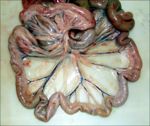Jejunum - Anatomy & Physiology
Jump to navigation
Jump to search
BACK TO ALIMENTARY - ANATOMY & PHYSIOLOGY
BACK TO SMALL INTESTINE - ANATOMY AND PHYSIOLOGY
Introduction
Structure
- The jejunum is the longest part of the small intestine.
- It is highly coiled and occupies the ventral part of the abdominal cavity, filling those parts that are not occupied by other viscera. This produces species variation (see comparative aspects).
- It is suspended by the mesentry (mesojejunum). This conveys the blood vessels and nerves and houses lymph nodes.
- The mesentry converges to its root. This is where the cranial mesenteric artery branches off from the aorta.
Function
- Has digestive and absorptive functions.
